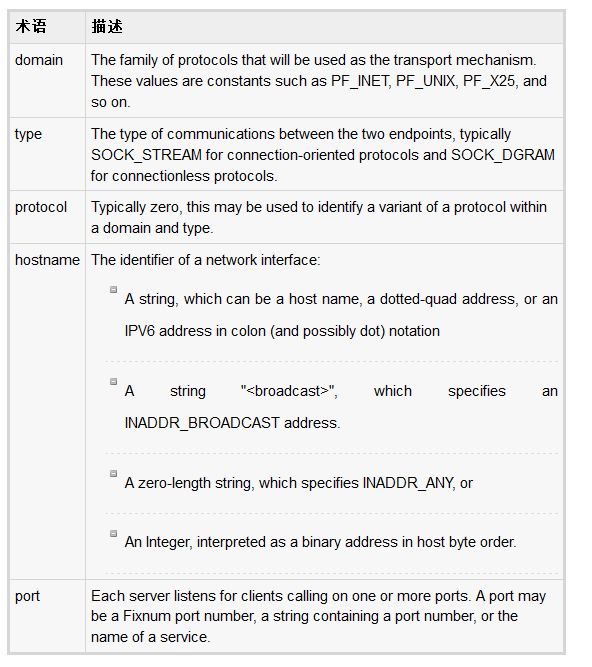這篇文章主要介紹了Ruby中的Socket編程簡單入門,是Ruby網絡編程學習中的基礎知識,需要的朋友可以參考下
Ruby提供了兩個訪問級別的網絡服務。在一個較低的水平,可以訪問底層的操作系統,它可以實現面向連接和無連接協議的客戶端和服務器支持基本的socket。
Ruby也具有程序庫,提供更高級別的訪問特定的應用程序級的網絡協議,如FTP,HTTP等。
這篇教程介紹 Ruby Socket編程概念及講解一個簡單的實例。
什麼是Sockets?
套接字是一個雙向通信信道的端點。socket能在一個進程,進程在同一台機器之間,或在不同的機器上的進程之間的進行通信。
套接字可實施過許多不同類型的通道:Unix主控套接字,TCP,UDP等等。套接字庫提供了處理,其余的用於處理常見的傳輸,以及作為一個通用的接口的具體類。
套接字相關名詞術語:

一個簡單的客戶端:
在這裡,我們將編寫一個非常簡單的客戶端程序,這將打開一個連接到一個給定的端口和主機。 Ruby的TCPSocket類提供open函數打開一個套接字。
TCPSocket.open(hosname, port ) 打開一個 TCP 鏈接到 hostname 在端口 port.
一旦有一個套接字打開,就可以讀它像任何IO對象一樣。完成後記得要關閉它,因為就像需要關閉一個文件。
下面的代碼是一個非常簡單的客戶端連接到一個給定的主機和端口,從套接字讀取任何可用的數據,然後退出:
?
1 2 3 4 5 6 7 8 9 10 11 require 'socket' # Sockets are in standard library hostname = 'localhost' port = 2000 s = TCPSocket.open(host, port) while line = s.gets # Read lines from the socket puts line.chop # And print with platform line terminator end s.close # Close the socket when done一個簡單的服務器:
要寫入互聯網服務器,我們使用 TCPServer 類。 TCPServer 對象是一個工廠來創建 TCPSocket對象。
現在調用TCPServer.open(hostname, port 函數指定一個端口為您服務,並創建一個 TCPServer 對象。
接下來,調用accept方法返回 TCPServer 對象。此方法將等待客戶端連接到指定的端口,然後返回一個表示連接到該客戶端的TCPSocket對象。
?
1 2 3 4 5 6 7 8 9 require 'socket' # Get sockets from stdlib server = TCPServer.open(2000) # Socket to listen on port 2000 loop { # Servers run forever client = server.accept # Wait for a client to connect client.puts(Time.now.ctime) # Send the time to the client client.puts "Closing the connection. Bye!" client.close # Disconnect from the client }現在運行在後台服務器,然後運行上面的客戶端看到的結果。
多客戶端TCP服務器:
大多數Internet上的服務器被設計來處理在任何一個時間大量的客戶請求。
Ruby的 Thread 類可以輕松創建多線程服務器。接受請求,並立即創建一個新的執行線程來處理連接,同時允許主程序等待更多的連接:
?
1 2 3 4 5 6 7 8 9 10 require 'socket' # Get sockets from stdlib server = TCPServer.open(2000) # Socket to listen on port 2000 loop { # Servers run forever Thread.start(server.accept) do |client| client.puts(Time.now.ctime) # Send the time to the client client.puts "Closing the connection. Bye!" client.close # Disconnect from the client end }在這個例子中有固定循環,並當server.accept作出響應並立即創建並啟動一個新的線程來處理連接,使用連接對象傳遞到線程。主程序緊接循環返回,並等待新的連接。
這種方式意味著使用Ruby線程代碼是可移植的以同樣的方式將運行在Linux,OS X和Windows。
一個微小的Web浏覽器:
我們可以使用套接字庫實現任何互聯網協議。例如,代碼中獲取內容的網頁:
?
1 2 3 4 5 6 7 8 9 10 11 12 13 14 15 require 'socket' host = 'www.tutorialspoint.com' # The web server port = 80 # Default HTTP port path = "/index.htm" # The file we want # This is the HTTP request we send to fetch a file request = "GET #{path} HTTP/1.0rnrn" socket = TCPSocket.open(host,port) # Connect to server socket.print(request) # Send request response = socket.read # Read complete response # Split response at first blank line into headers and body headers,body = response.split("rnrn", 2) print body # And display it要實現類似的web客戶端,可以使用一個預構建庫,如 Net::HTTP 與 HTTP 一起工作。下面是代碼,這是否就相當於之前的代碼:
?
1 2 3 4 5 6 7 8 9 10 11 require 'net/http' # The library we need host = 'www.tutorialspoint.com' # The web server path = '/index.htm' # The file we want http = Net::HTTP.new(host) # Create a connection headers, body = http.get(path) # Request the file if headers.code == "200" # Check the status code print body else puts "#{headers.code} #{headers.message}" end請檢查類似的庫,FTP,SMTP,POP,IMAP協議。